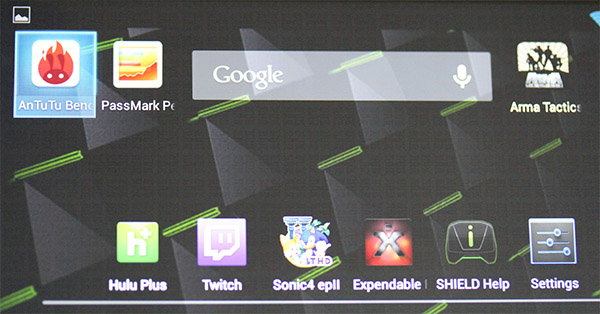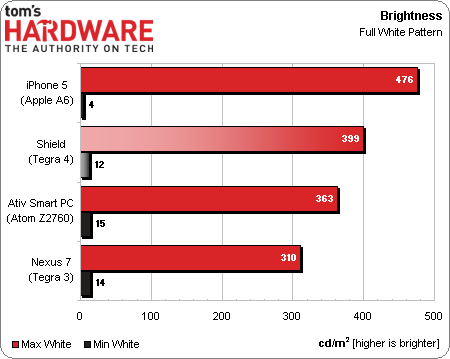Nvidia Shield Review: Tegra 4-Powered Handheld Gaming
We've been playing with Nvidia's Shield handheld for more than a month, but only recently got access to its killer feature: streaming PC game content. Does Nvidia's foray into the hardware world deserve your $300, or is this expensive toy impractical?
Touchscreen And Sound
Display
With a resolution of 1280x720, most elements on the 5” display are easy to read. If you find yourself on a webpage with tiny text, the multi-touch screen makes it easy to expand with two fingers and pinch to restore.
I cannot emphasize enough, though, that I wish it were easier to hold Shield for touchscreen navigation. Coming from Android-based phones and tablets, we’re used to touch being a first-class citizen. Here, it feels like touch was added after the handheld had already been sketched out.
One thing to keep in mind is that Shield is locked into a landscape orientation. Flipping it on its side or upside-down doesn’t auto-rotate the screen to keep it right-side up. Likewise, some of the apps available through Google Play don’t support auto-rotate. The first Shield unit we received simply threw up errors when we’d try to download those apps, Netflix the most notable. A recent update better-supports them, and it's now possible to use titles previously reported incompatible.
Otherwise, Shield’s screen looks good. You don’t hold the console as close to your face as you might a lighter cell phone, so the ~294 PPI density is ample. There is no light sensor to speak of, so brightness has to be adjusted manually. Maxed out, Shield is usable outside in the shade, though the capacitive elements under the glass are clearly visible and somewhat distracting. Just don’t expect to game out on the beach under direct sunlight. You’re better off donning earbuds and enjoying those 40 hours of music Shield purportedly delivers on a single charge.
Sound
In pretty much every discussion I’ve had about Shield, Nvidia’s work with the audio system comes up. The company is especially proud of the effort its sound team put into creating a ported stereo configuration, really emphasizing the low-end response this facilitates.
Get Tom's Hardware's best news and in-depth reviews, straight to your inbox.
To Nvidia’s credit, Shield does outperform any handheld I’ve ever used. If you put clean source material through it, you get no distortion at full volume. It’s so treble-heavy and inevitably close to your ears that you won’t even want to turn the sound up all of the way. Dialed back a couple of notches, you get nice audio. Shield’s size also paves the way for noticeable stereo separation.
However, there’s no getting around physics, and despite the enclosed configuration enabled by a roomy chassis, I came up with song examples from several genres just off the top of my head where bass lines simply disappeared when I played them through Shield. You get more response across the spectrum from a $75 headset or $130 Jambox. Fortunately, Nvidia supports the former through a 3.5 mm jack on the back of Shield and the latter through Bluetooth 3.0 support. Or, if you hook Shield up to a receiver, it’ll output eight-channel PCM.
Current page: Touchscreen And Sound
Prev Page Nvidia Shield: The Chassis And Controls Next Page Adapting Android To Support Shield's Input-
Hazle impressive, especially PC streaming. but for $300, i'd rather pause the game to take a bathroom break. it's gonna take me a library of good android exclusives for me spend that amount of money, and PvsZ or Angry birds don't cut it.Reply -
beta212 Meh, with the PS4/xbox coming out , and tons of more convenient phones I don't see a market for a tegra4 shield, personally I'm saving my money for a console. The tegra is also too expensive and gimmicky to boot.Reply -
dragonsqrrl When you look purely at the performance and specs $300 unsubsidized isn't all that bad considering the hardware you're getting for the price. The problem to me isn't so much price but the target market. How many people are willing to spend that much on a second or potentially third mobile device meant specifically for gaming and entertainment?Reply -
bryonhowley Looks nice but I can find things better to spend $300 on. In truth I can't see ever streaming my PC games to a 5" screen when I use 3 Asus 27" monitors on my desktop PC. Going from 5760x1080 to 720p does not sound like something I am ready to do. And if I want to game from my recliner I just use my Xbox 360 wireless controller and play the game on my Panasonic 50" 3D Plasma.Reply -
vaughn2k for U$180, I can get a nice Lenovo Phone. For U$ 500, a good Xbox.. not sure if I need a Shield where I could play anywhere..Reply -
slomo4sho Not sure why most of your benchmarks were just between the shield and the Nexus 7. I understand that the Nexus 7 utilizes Tegra 3 but the iPhone 5, Note 2, or some other tertiary figues should have been included to provide a better comparison between this device and other current generation products.Reply
This device feels like a universal Wii U game pad and there is almost zero reason to own one. -
cats_Paw Considering that Oculus rift will cost somewhere around 300 dollars as well, id rather wait for that to spend my cash.Reply
Streaming is nice but if you are close toy our pc why not use the PC itself?
-
shikamaru31789 I'm just not seeing much reason to get one right now, not when I'm saving for the Xbox One and PS4. If it was at a lower price and if it supported AMD GPU's for PC streaming, I might get one. But they also need to get some developers to make some good Android exclusives, not just your typical mobile time wasters and ports of older console/PC titles, but some actuallAAA exclusives that are optimized for Tegra 4.Reply





